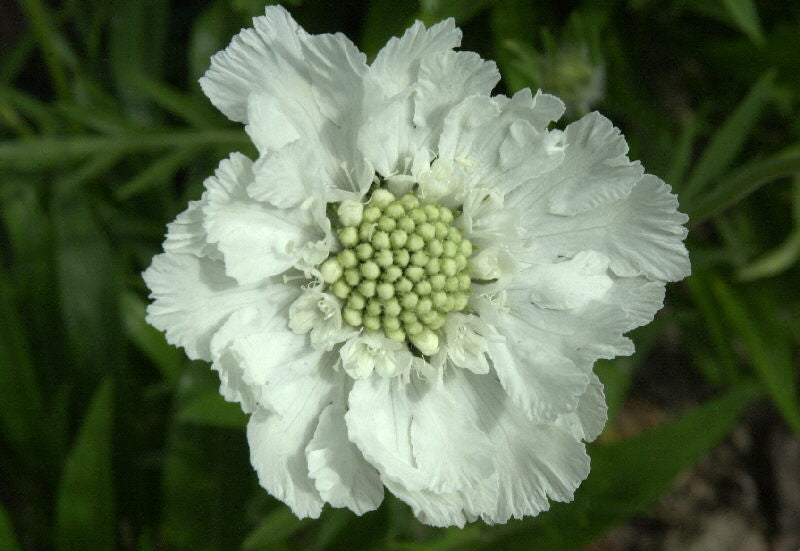Scabiosa caucasica 'Miss Willmott'
Approx. 0.5 litre pot
About this cultivar:
Scabiosa caucasica ’Miss Willmott’ is a cultivar that forms a clump of feather shaped leaves that from June have erect wiry stems each with a single creamy-white pincushion flower 2-3 inches wide. It was first introduced by market gardener James House, who ran a successful nursery near Bristol. The House family dubbed this white form 'Miss Willmott' in honour of Ellen Willmott who gardened at Warley Place in Essex. It probably was introduced in the 1930s.
The species, Scabiosa caucasica, was introduced into Britain in 1803 after seed collected from the Caucasus was sent to the Hackney nurseryman George Loddiges. In the wild it is found in cool meadows and in the garden this plant seems to peak once the heat of summer starts to wane.
- Position: Full sun, partial shade
- Soil: Almost any soil
- Flowers: June, July, August, structure: September, October
- Other features: Grows well in Ballyrobert, Royal Horticultural Society Award of Garden Merit (RHS AGM), Bees and Butterflies, Cut Flowers or Dried Flowers
- Hardiness: Fully hardy, grows well in Ballyrobert
- Habit: Clump forming
- Foliage: Deciduous
- Height: 45 - 75 cm (1.5 - 2.5 ft)
- Spread: 45 - 75 cm (1.5 - 2.5 ft)
- Time to full growth: 2 to 5 years
- Plant type: Herbaceous Perennial
- Colour: Green, white
- Goes well with: Monarda, Stachys, Perovskia, Molinia, and Penstomen.
About this genus:
Scabiosa (skab-ee-OH-suh) is a genus in the honeysuckle family (Caprifoliaceae) of flowering plants native to Africa, Europe and Asia. Many of the species in this genus have common names that include the word scabious; however some plants commonly known as scabious are currently classified in related genera such as Knautia and Succisa; at least some of these were formerly placed in Scabiosa. Another common name for members of this genus is pincushion flowers.
The genus name ‘Scabiosa’ derives from the word scabies, which comes from the Latin word scabere meaning “to scratch" or "itch". In medieval times species of scabious the plants were believed to relieve the itch of scabies and other afflictions of the skin including sores caused by the Bubonic Plague. In the 17 century Nicholas Culpepper prescribed its root as an ointment for the cure of wounds, swollen throats, snake-bite and the plague.
I read, all over the internet, that Scabiosa atropurpurea was the first scabious to be introduced into cultivation in 1591. But I cannot find any evidence for this!?!? It seems very early! It is mentioned the 1751 book "A General Natural History Or New and Accurate Description of the Animals" By John Hill. Never mind, I don't have much evidence for much that I write....
Some species of Scabiosa are annuals, others perennials. We only sell the perennial types. Some are herbaceous plants; others have woody rootstocks. The leaves of most species are somewhat hairy and partly divided into lobes, but a few are smooth and some species have simple leaves. The flowers are borne on inflorescences in the form of heads; each head contains many small florets, each floret cupped in a membranous, saucer-shaped bract. Scabiosa species and varieties differ in the colours of their flowers, but most are soft lavender blue, lilac or creamy white. NO matter what the colour though they are loved by insects – they are rich in nectar.
After the flowers have dropped, the calyces together with the bracts form a spiky ball that may be the reason for the "pincushion" common name. The calyx is persistent and remains as a crown on the fruit after it is shed. So you get great structure even after flowering has finished.
They will grow is most places that are deserts, puddles, or in full shade. I would say though that full sun is nicer. I say that for most ‘structural plants’ because they make a great back drop to sunrise and sunset. Also so you can see the insects buzz around them.
Save your ‘big flowers’ like roses, peonies etc to brighten up part shade places I say. I’m sure I’ll change my mind though…
Much like Knautia we have a few different colours and cultivars growing around our garden. We plant them through a variety of plants like Monarda, Stachys, Perovskia, Molinia, and Penstomen. Although we also grow a few species on their own near the edge of the garden for a big, bushy, airy, wildflower-ish effect. Makes a great cut flower.




